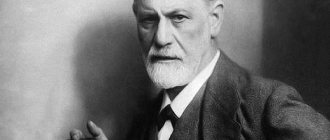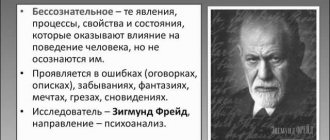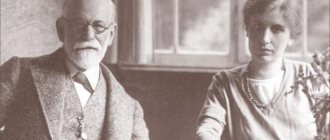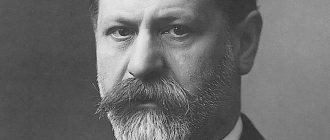Psychoanalysis and its effectiveness are confirmed by the research of biologists and the rich clinical practice of psychoanalysts. How does psychoanalysis work and where is the unconscious located?
Let's start with a clinical example.
The patient, a man, 44 years old, relates a dream at the end of the first year of psychoanalysis:
“I am standing at a well and looking down.
I know that there are five more people down there in the dark. I have a great feeling of guilt . The patient gave his own interpretation, with which the psychoanalyst agreed: “At the after-school program at school, besides me, there were five more people in the group and I was tormented by remorse that not much attention was paid to them because of me... Yes, I fantasize that Besides me, you have five more people and you have to spend a lot of energy on me, so there is little left for them.”
A couple of months later, the patient’s mother died and the grandmother told a terrible family secret: “After the patient was born, the mother had five abortions!” And this guilt of the mother due to abortions was unconsciously “transferred” to the patient and therefore he also began to feel guilty for their death, WITHOUT RECOGNIZING what actually happened , i.e. That is, the unconscious exists and influences us against our will!
Now let’s compare psychoanalysis and biology.
The cerebral cortex analyzes the surrounding reality and looks for those manifestations of it that you have already become acquainted with in the past, comparing them with each other.
The limbic system produces active biological substances - neurotransmitters, which are responsible for hormones. Neurotransmitters tell you: “This is good for you” or “This is bad for you, avoid it.” The body does not always follow the instructions of neurotransmitters, since the cerebral cortex can override it. The cortex rationally
analyzes information, and the limbic system motivates us to action.
The picture shows: the cerebral cortex receives the stimulus “A guy is telling me something on the phone”: and the limbic system unconsciously interprets this with feelings: “This is good” or “This is bad.” The developed
cerebral cortex distinguishes us from animals, thanks to it new ones are formed neural connections and pathways. However, the cerebral cortex sees around only a large number of unrelated details, and only the limbic system creates in us a sense of what is “good” and what is “bad” for us, by the fact that the neural connections that produce or joy hormones (dopamine, endorphin, oxytocin and serotonin) or stress hormones (such as cortisol). The cortex is our verbal thoughts, and the limbic system does not operate with words, so we feel unconsciously.
Neural pathways are shaped by our individual life journeys, which is why we respond differently to different events. Positive experiences create neural pathways that produce happiness hormones, and negative, traumatic experiences create neural pathways that produce stress hormones. And the person wants to avoid in the future the neural connections that were formed as a result of the injury. Example: A boy was praised for his performance in front of his parents.
. This formed positive neural pathways of “Getting up in public is a joy.” He can become a successful actor because these positive neural connections will be activated and constantly bring joy hormones. Of course, success is not only about “positive neural connections”, but also about hard work, talent and good life decisions with a bit of luck.
Another example, a father humiliated a girl
and this formed the neural connections “Relationships with a love object are stress, resentment, pain.”
Such a girl will avoid relationships with men in order to avoid prolonged activation of these neural connections. Patterns of negative relationships are constantly repeated in life due to the work of the limbic system and psyche - psychoanalysis calls this “transference” .
The cerebral cortex can “correct” old neural circuits! Psychoanalysis deals with this process! By reliving the traumatic experience in the office and interpreting it, negative neural connections change!
Sigmund Freud was the first to prove the influence of the unconscious on our lives.
Psychoanalysis arose at the dawn of the twentieth century thanks to the talent of the famous Austrian psychiatrist and psychologist Sigmund Freud, who proved that our consciousness is only a small part of personality. Our daily lives are powerfully influenced by the unconscious
- our secret drives and traumas tend to come out.
However, the unconscious is opposed by our mental censorship (parental and social prohibitions), and at the junction of this conflict all kinds of mental traumas, neuroses, phobias, etc. are born. Karina abandoned the child and went to the brothel, at the “order” of her unconscious.
And only in psychoanalysis did I understand this... An example of the influence of the unconscious on our lives. A successful businesswoman, Karina, began drinking after the birth of her daughter. Her tragedy was observed by all her friends, but they could not fix anything: after a while, Karina sent her daughter to an orphanage, and she herself went to live with a gay alcoholic. She lost her business, home and child. From the point of view of “simple life” it is difficult to explain, but the psychoanalytic solution to this grief of Karina lies in the fact that even in early childhood, her alcoholic mother sent her to an orphanage. Karina didn’t even remember her mother, but the events were firmly deposited in her unconscious. After the birth of a child, every mother relives her early problems and mental conflicts that have already existed in her life. Karina, after the birth of her daughter, again unconsciously experienced conflicts in the oral phase of her development (from birth to one year of age), when her mother drank, when Karina lacked her warmth and affection, when she was sent to an orphanage. And what happens: she, like her mother, abandoned her daughter and started drinking. Karina again felt an urgent need for maternal care and therefore found a substitute mother - a drinking woman of unconventional orientation. Fortunately, later Karina turned to a psychoanalyst for help and she began to get out of this problem: she had already left the woman, stopped drinking and would soon take her daughter from the shelter.
After the birth of a child, every mother relives her early problems and mental conflicts that were already in her life
Psychoanalysis is a personality-oriented method, i.e. its focus will be on the patient as a whole. In the process of psychoanalysis, self-awareness and self-understanding of the personal unconscious occurs - the keys to changing psychological attitudes, overcoming anxiety and fear. However, for psychological changes we need an object, i.e. a psychoanalyst onto whom we project our emotions - without this it is impossible to understand the deep aspects of our essence! This is why a heart-to-heart conversation with a friend will not replace psychotherapy, because... in an ordinary conversation, everyone listens to themselves, and only in a dyad with a psychoanalyst are healing transformations possible.
What is psychoanalysis?
Psychoanalysis is a unique technique of self-knowledge, the founder of which is Sigmund Freud. Revolutionary theory consists of a radically different view of the inner life of man.
Psychoanalysis is a profound practice that helps change human destiny. Giving you the opportunity to understand your true Desires.
And by understanding our desires and our own unique history, we are given the opportunity to “consciously” live life and are given a choice where there was none before.
Who is a psychoanalyst?
A psychoanalyst is a person who has a specialized psychological or medical education and has undergone additional retraining in this area. There are main ways to become a psychoanalyst: 1) Appropriate education and a certain amount of supervision; 2) Reading books on psychoanalysis (Freud and his followers); 3) Own analysis, and it is at least 250 hours. This is necessary in order not to shift your own problems onto the person.
Therefore, when choosing a specialist, ask where and how many hours he himself lay on the couch.
There is an interesting video where Professor M. Reshetnikov discusses the topic of modern psychoanalysis and what the work of a psychoanalyst consists of.
So what is the main difference between psychoanalysis and other psychological techniques?
Psychoanalysis works to change the structure and character of the psyche, to find out the root cause and work through it, and not to relieve the symptom.
Psychoanalysis was the first to discover the method of “healing” by talking and, probably, that’s why he succeeded in it better than anyone else. The special technique of free association provides tremendous success in becoming aware of the unconscious. The technique is distinguished by a special way of thinking, in which a person says everything that appears in his thoughts. Trying not to criticize and discard unnecessary things. The trick is that there is nothing unnecessary. At the same time, the psychoanalyst, knowing how to listen in a certain way, analyzes everything that is happening now in the office and tries to understand where the unconscious has manifested itself at the moment.
Essentially, a psychoanalyst is a person who analyzes your echoes of the unconscious and presents them in a “digestible” form.
A small remark, the unconscious is all that part of our psyche that has a colossal influence on our lives and, for some reason, is not in the field of consciousness. The causes of our neurosis, phobias, true desires and much more can be hidden in the unconscious.
In the process of analysis, a person acquires memories of his own unique history, the ability to understand his desires and an awareness of cause and effect. At the same time, a colossally important right of choice is acquired where it did not exist before. Therefore, the analysis cannot be fast. After all, you need to have respect for your neurosis, which has been developing throughout your life. And you want to get rid of it in a couple of sessions. There is one unshakable rule in psychoanalysis: each subject is unique. This is reflected in the fact that the analyst never takes the position of “truly knowing.” And he will never give you advice or some techniques that you will need to use. Because, behind the seemingly “understandable” symptom and the sweet position of the “knowledgeable teacher,” there is a huge mistake in not seeing the unique structure of the analysand’s psyche and fate.
Psychoanalysis is like an island of freedom.
In the modern world, where a superficial view of man prevails. Where great attention is paid to external indicators and success. And a person devotes all his free time to “upgrading” himself and creating an image. Psychoanalysis remains an island of freedom, where the inner world is important, without trying to adapt it to current reality. The opportunity to meet yourself, without any evaluation from the analyst, gives you a chance to get to know your own true desire, to freely express your thoughts and emotions.
Why do people turn to a psychoanalyst?
Each person is a unique story and therefore appeals may be different. This could be a feeling of apathy, the meaninglessness of life, a feeling of emptiness, obsessive states, phobias that repeat life situations, a crisis in relationships, experiences of grief, loss of meaning in life, as well as any other topics that you would like to discuss. The psychoanalyst represents the image of a guide who does not judge or give advice, who walks alongside you and illuminates your path with a flashlight, as he has a map of the area. A listener who will not leave any of your thoughts unattended.
How can you understand a person and thereby help him understand himself?
Psychoanalysis
is a method that helps a person understand himself.
This becomes possible due to the expansion of consciousness
, when previously inaccessible parts of the psyche become conscious.
Unconscious areas of the psyche are called the unconscious
.
The study of the unconscious is associated with immersion in depths, which is why psychoanalysis is also called depth psychology.
.
It may seem that only with the help of hypnosis is it possible to “look” into the depths of the psyche. But that's not true.
::
Psychoanalysis as a technique for treating neuroses appeared more than 100 years ago thanks to the cathartic method of Joseph Breuer
, who used hypnosis in his work (see
Talking therapy
).
Freud was a student of Breuer and also initially used hypnosis in his practice, but soon became disillusioned with it (see How hypnosis works
).
The day when Freud began treating his patient without resorting to hypnosis can be considered the birthday of psychoanalysis
(see
Prisoners of Conscience
).
Psychoanalysis
and
psychoanalytic psychotherapy
is always carried out with the patient (client) awake. Wakefulness is necessary because the psychoanalytic method involves the patient's active participation in the process of self-discovery.
Who is a psychologist?
A psychologist is a specialist with a humanitarian education. This is like a connecting word for the general definition of people in this profession. Psychologists are:
• people working in the field of theoretical scientific issues. Practitioners involved in testing and various studies. • psychologists in schools, kindergartens, clinics and other government institutions. The job is low-paid, so don’t expect to meet a smiling person there who is ready to listen and sympathize with you for hours on end. • specialists in private practice (in the common people, they can “illegally” call themselves psychotherapists). We’ll talk about them in more detail below, since the directions there are a carriage and a small cart. • Clinical psychologists working in a psychoneurological clinic and focused on deep mental disorders.
In what cases do you contact a psychologist:
• Depression, feeling of apathy; • Loss of a loved one, separation, death; • Feeling of loneliness, incomprehensibility; • Sharp outbursts of rage or excessive shyness, passivity; • Lack of understanding of your feelings, confusion in thoughts; • Professional burnout; • Personality crises: teenage, middle age, etc.; • Panic attacks, phobias, fears; • Loss of interest in life; • Experiencing a traumatic situation; • Problems in relationships with people. • Sexual problems; • See the motivation and implementation of internal resources. The list is not complete, since each person is individual and the job request also cannot be classified.
What directions exist in psychology?
Oooh, this is where all the variety of methods and directions that exist at the moment is.
Let's go over the tops of these icebergs and briefly describe them:
1. Psychoanalysis. The brilliant creation of S. Freud, which provided the foundation for many modern trends. And what caused great damage to a person’s pride for the third time was the discovery of the unconscious and the description of the structure of the psyche. Copernicus was the first to point out that the Sun does not revolve around the Earth, but rather the Earth revolves around the Sun. The second is Darwin, with his theory of the origin of man from the ape. And the third is Freud, who showed that what a person is aware of about himself is not him. The theory is focused on deep psychology, working through internal conflicts, and deep understanding of oneself and one’s true desires. Since the process tends to go deeper, it takes longer. Therefore, therapy is long-term. Well, it was described in more detail earlier.
2. Transactional analysis. The founder of the theory, E. Berne, a follower of psychoanalysis, created his own theory of personality. Therapy is based on the interaction of three ego components of a person: the inner parent, the adult and the child. This interaction occurs both in the outside world, when communicating with other people, and as an internal dialogue with oneself. Internal dialogue often takes the form of conflict, filled with difficult feelings. A striking example of this: “I want” and “I need.” In the process of therapy, these parts are analyzed, getting rid of negative influences, exploring childhood experiences and how the outcome appears “Choice”.
3. Gestalt therapy. Gestalt is something holistic, complete. And therefore therapy is based on completing the processes that interfere with life (unfulfilled needs, unpleasant situation, resentment, anger, etc.). Closing the gestalt provides liberation from it. Why is it so important to close the gestalt? - because this is a time bomb, it is not clear when and where it will explode. Also, one of the areas of therapy is that this skill is in the moment, as it is now fashionable to say “here and now.” In therapy, great attention is paid to feelings as a guide to one’s own needs, the environment and the satisfaction of these needs in interaction with the world.
4. Symboldrama. Or the “daydreaming” method is free fantasy on any topic or one previously presented by a psychologist. The process goes as follows: a person relaxes, imagines an image, retells it to the therapist and analyzes it with him. The method gives a softer touch to traumatic situations and unconscious fantasies. Symboldrama is suitable for people with a developed emotional and figurative structure of experience, an irrational way of solving mental problems.
5. Cognitive behavioral therapy. In my opinion, it works great for relieving symptoms and developing new thinking skills. It is intended for short-term therapy, usually 10-15 sessions. On which you will be able to realize the main errors in thinking and reaction behavior. During therapy, it becomes clear what negative attitudes and thoughts influence behavior. The situation lends itself to critical thinking and negative attitudes are replaced by positive ones. That is, the main task of a specialist is to get to the essence and teach a person techniques of positive thinking.
6. NLP or neurolinguistic programming. It has in its arsenal special techniques for modeling verbal and non-verbal behavior and developing special connections between eye movements, memory and speech. If you retell all this in ordinary human language, it turns out that you are trying on the mask of a successful person and trying to adjust these skills in yourself in order to achieve success in the same area.
7. Art therapy. A direction in which psychology and art and creativity merged. What is difficult to express in words is expressed well in creativity. That is, when immersed in any process, be it drawing or dancing or music, our “cunning mind” forgets about caution and shows our emotional state and inner experiences as they are. And at the same time, an excellent opportunity arises to process, that is, to “pour out” some of the internal emotions that we have so diligently restrained (for example: sadness, pain, fear, euphoria, etc.). It is an excellent diagnostic tool if you have an experienced specialist with you who can decipher your creative product.
C. G. Jung's theory of personality
Jung devoted his life to the study of unconscious drives. However, unlike Freud, Jung argued that the contents of the unconscious are more than repressed sexual or aggressive urges. According to Jungian analytical psychology, individuals are motivated by intrapsychic forces and images whose origins go back to the origins of evolution. This innate unconscious contains deep-rooted spiritual material that explains the inherent desire for creative expression in all humanity.
3 pages, 1090 words
The concept of human personality in psychology
... from 7 to old age) The concept of human personality in psychology The following aspects are important for psychological analysis: ... habits). 4. personality orientation – the highest level, hierarchically connected series. 1) desire, attraction, inclination 2) ideals 3) individual ... discharge in the external environment. The ego is the executive organ of the personality. 3. Super ego (super ego) – represents the internalized version of ...
Jung proposed his concept of personality. He argued that personality consists of three interacting structures: the ego, the personal unconscious and the collective unconscious.
— the ego is the basis of our self-awareness.
— the personal unconscious contains personal information that has already been suppressed or forgotten. Here are emotionally charged thoughts, feelings and memories drawn from personal and ancestral (hereditary) experience.
— the collective unconscious is the repository of human memory. Jung said: “The collective unconscious contains the entire spiritual heritage of human evolution, reborn in the structure of the brain of each individual.”
10. Basic mental processes. Sensation and perception.
Who is a psychiatrist?
Let's start with a psychiatrist, about whom all sorts of horror stories have been circulating from generation to generation since Soviet times. A psychiatrist is a doctor who has received medical education. He works, in most cases, with psychopathologies, i.e. with mental disorders.
When should you contact a psychiatrist?
- In the presence of delusional thoughts, which manifest themselves in confidence in something that actually does not exist;
- The presence of voices, visions and other manifestations of hallucinations;
- Violations of criticism regarding one’s own behavior;
- With deep depression;
- Panic fear;
- Behavior that is inexplicable to others;
- Problems with attention, thinking and memory;
- For drug or alcohol addiction.
Etc., the list can go on and on, but I think, in general terms, several points can already give an understanding of why they visit a psychiatrist.
How is the treatment carried out?
This usually happens like this: the doctor recognizes your symptoms, examines the cognitive part and, based on his invaluable experience, makes a diagnosis and prescribes medication. Accordingly, he bears full legal responsibility for this.
He does not listen to your stories about the injustice of your childhood about an overprotective mother and an overly demanding father. Not because he is a callous and boorish person, but because he is first and foremost a Doctor and is focused on drug treatment. In addition, there is a regulation according to which a maximum of 15-20 minutes is allocated for each patient, and there are other specialists for conversations.
Can someone other than a psychiatrist (for example, a psychologist, psychoanalyst, etc.) give a prescription for medications?
No, because only a DOCTOR can write prescriptions. This applies to both strong antipsychotics and conventional antidepressants.
Do they register with the PND (psychoneurological dispensary) when visiting a psychiatrist?
There is an opinion that when contacting a psychiatrist, a person will be immediately registered. Let's understand today's realities of life.
Observation and treatment by a psychiatrist are divided into: 1. Medical and advisory assistance. 2. Clinical observation.
From the first it follows that the patient voluntarily comes to see the doctor and also voluntarily takes medications. If he suddenly changes his mind, no one will look for him and find out what’s wrong with him. Dispensary observation is not carried out in this case.
In the second case, if there is a mental disorder that occurs with severe exacerbations and periodicity (for example, paranoid schizophrenia), then a commission of psychiatrists, on the initiative of the attending physician, establishes dispensary observation for the person. This means that the patient is treated at his own request, but according to a certain schedule he needs to visit the attending physician for examination and prescription of medications. To place a person under dispersed observation, his condition is monitored for a long time. It is illegal to establish surveillance after the first visit.
Where are the roots from?
I spent a long time trying to figure out why psychoanalysis is so popular.
One acquaintance said that his parents are ardent supporters of psychoanalysis, because at the sociology department of St. Petersburg State University in the 90s, psychoanalysis was taught as a subject (maybe it still exists), it was introduced into the educational program. There is even an entire Institute of Psychoanalysis in St. Petersburg (guess what year it was founded). I can forgive our education a lot. I can forgive the obsolescence of the IT program. BUT, one cannot forgive the officials who, for money (most likely) pushed an outdated school of psychology into TOP universities, which is not based on research (in normal countries it would be cut off for this reason) and is used in private clinical practice to pump out money. I believe that in the 90s (and even now) psychoanalysis was very convenient for three reasons:
- Psychoanalysis involves many sessions and no guarantee of results, as well as a lack of responsibility. The population of Russia believed in fortune tellers and charged water on TV at that time, and was very well suited for hilling
- The very word “psychoanalysis” is consonant with the word “mathematical analysis” and it seems that this is some systematic approach to the study of human consciousness, by analogy with mathematics, which is used to describe phenomena in science and quite successfully
- The arrival of “everything” Western consisted mainly of entertainment content, which contains many references to psychoanalysis due to its mementic nature. But suitable approaches from Western medicine come much more slowly
- Collapse and devastation in medicine. The average Russian does not trust the average doctor (and with good reason). From my own experience, even in modern medicine in St. Petersburg I have seen a huge number of mistakes (including very gross mistakes, there will be separate articles about them). A doctor in the Russian Federation is not an authority for a Russian. If he refers you to CBT, the Russian can still go to a psychoanalyst
Although, these are my guesses. If among the readers there are those who worked in this field in the 90s, let them explore this topic in more detail.
Psychotherapist and his difference from a psychiatrist
In Russia, only psychiatrists who have completed additional education in the field of psychology can be called a psychotherapist. They are like a connecting link between psychiatrists and psychologists.
Surprisingly, in the countries of Europe and America there are no such strict criteria; their psychotherapists can be both psychiatrists and psychologists. Therefore, our ordinary Russian people are often confused by foreign films with figures of psychotherapists. Who, sitting in a chair, with a languid look, receive the client lying on the couch and conduct conversations with him, due to which the treatment takes place. In Russia, this is usually done by psychologists.
To summarize, a psychotherapist is a psychiatrist who has decided to move to the “dark” side of psychology and start helping people in a non-medicinal way. You can turn to him both in severe psychopathic conditions and to solve pressing disturbing moments in life. But in the realities of our time in Russia, psychotherapists are called all and sundry, including psychologists and psychiatrists))) On a side note, I would like to note that the education of a doctor does not always give an advantage in competence and usefulness for you. In this delicate profession, it is the personality of the specialist who treats and it is better to focus on this when choosing. So psychologists are often much more productive for a person because they do not look at you from the perspective of a patient.
To summarize, we can say that when choosing which specialist to go to for one reason or another, one should not forget that the main figure is not the method in which he works, but the person himself. Therefore, carefully check the education, competence and availability of your own analysis. And don’t forget about the feeling of comfort and safety in the office, because in order to trust you need to trust.
Crowd Psychology
The founders of social psychology, Gabriel Tarde, author of the book “The Laws of Imitation” (1890) and Gustav Le Bon “Psychology of the Masses” (1895), gave a clear description of the psychology of the crowd and man as part of the crowd, the mass.
What changes, in their opinion, happen to a person when he is among a mass of people?
The inclusion of the individual in the mass leads to depersonalization, to the fact that the individual becomes averaged and loses his personal qualities. He seems to degrade while in a crowd, his criticality decreases, personal responsibility and fear disappear, confidence and a feeling of increased power appear, so in a crowd a person does not assess the magnitude of the real danger. People's suggestibility increases. In a crowd, feelings dominate over reason. The crowd is impulsive and aggressive. In a crowd, emotions and actions are highly contagious - they are quickly transmitted from one person to another.
The crowd is a primitive herd that needs a strong, powerful and authoritative leader. She will obey the one who calls herself her leader and declares respect and love for those gathered. You need to be able to talk to a crowd: speech should be emotional and simple, not lose eye contact with people, promise and say what the crowd wants to hear, because it craves illusions. The crowd needs the love of the leader and can make any sacrifice if he calls.
2 pages, 941 words
Qualities and personality traits of a leader
... leaders and values on the scales of R. Cattell’s test, characterizing respondents as leaders. Currently, the most sought-after quality of a leader’s personality is leadership potential. ... the potential of a leader showed that with obvious attention to the problem of the activity of a leader, many questions regarding the concept and structure of the leadership potential of a leader as a subject...
It is unsafe to be in a crowd, because while being in a crowd people’s psyche changes.









